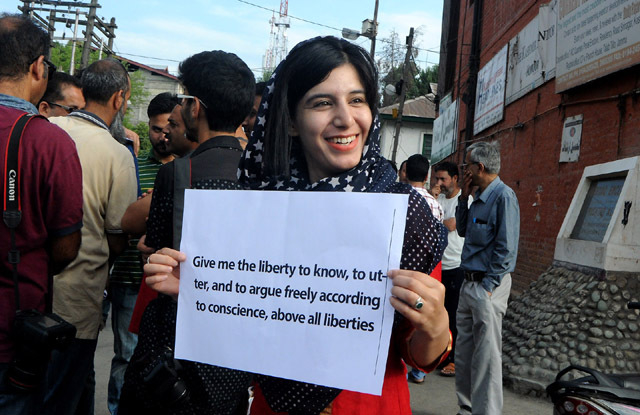Mehbooba Mufti Shoots the Messenger Yet Again

SRINAGAR: The media has been having a rough time in Jammu and Kashmir, more so in the last 88 days of curfew and violence. Apart from reporting at great risk to life in a conflict zone, the Valley media is now facing direct threat from the state government. Chief Minister Mehbooba Mufti has moved to ban the publication of major newspapers like Greater Kashmir, Rising Kashmir and others in the Valley, lifting it after three days of protests that found an echo in New Delhi. She then instructed cable operators not to telecast several local channels. The latest is the ban imposed on Kashmir Reader.
Hilal Mir, Editor of Kashmir Reader, has written an article in Greater Kashmir about the ban, and why he thinks the government has decided to shoot the messenger yet again/ The article is reproduced below.
Why has been banned? This is the question I have been asked by several reporters, representatives of rights organisations, concerned colleagues and friends since Sunday evening, when a posse of policemen delivered at our office the Srinagar district magistrate’s gag order, intriguingly dated ‘30.9.2016’.
The contents of the order are, more or less, self explanatory. It says the newspaper “contains such material and content which tends to incite acts of violence and disturb public peace and tranquillity”. Has the government pointed out such content to us or sought an explanation from us? No. The question therefore lingers. Why?
There are no simple answers, although one can call it an assault on the freedom of speech and rest. A few days into the raging uprising, the state government asked newspapers to suspend publication for three days. The government spokesman said the government apprehended “trouble over the next three days and suspending publication was considered necessary”.
And when it couldn’t handle the embarrassment triggered by international outrage, the chief minister’s advisor first denied that a ban had been imposed and requested the newspapers to resume the publication.
When the government spokesman announces the ban and the CM’s advisor does the fire fighting, it shows the government’s capability to handle the fourth estate has taken a hit. A media gag at the peak of a mass uprising has far reaching consequences. The perfunctory manner in which the ban was announced should have spurred some introspection in the government.
Instead, the ‘administration’ put the muzzle on Kashmir Reader. Only this time the gag order comes with legal armour, apparently to frighten the rest of the local media into submission.
A day before the ban was imposed, one of our reporters called a senior police officer for information about a story. The officer told him that he should start looking for a job as Kashmir Reader would be shut down sooner or later. The officer labelled the newspaper as “Lashkar-e-Toiba’s own organ”. The conversation, which the officer would probably dismiss as a joke, is frightening. If a senior police officer perceives a newspaper as the property of a militant outfit, we naturally become the legitimate targets of a ‘surgical strike’.
The same mindset is pervasive in the structure of the state. Hardly any official or minister expects a reporter to question him about a story in a detached, professional manner. The professional aloofness is considered an affront to the power.
Media can function professionally in an atmosphere of mutual respect. A reporter’s job becomes easy when officials are available to answer to their queries. It becomes more important in emergency situations. Will a police officer’s belligerence help a young reporter grow professionally? Will it not colour his perception of the entire police force?
The perennial complaint of the state that the local media coverage is “biased, baseless, motivated” exists only because the state functionaries and its PR system have been largely unresponsive and unprofessional.
In a situation, where scores of events are occurring every day, isn’t it incumbent upon the government to proportionately strengthen its media outreach? Unlike Indian and international media outlets, the local media has to process a larger number of stories every day. Therefore, the state and its organs should be easily accessible for the local media so that the reportage is fair and balanced. No professional organisation would want to publish reports that do not carry as many sides of the story as possible.
Now, Kashmir Reader has been accused of publishing content that “incites acts of violence and disturbs peace”. It would have been helpful if the gag order had made a mention of a specific report so that we could answer it.
But in the absence of such communication, we assume that it is a generalised accusation. Newspapers were not published for three days but the ‘violence’ persisted. Who incited the violence during those three days? The government’s mishandling of the media springs from its wilful refusal to accept the reality on the ground. The state should take a hard look within to seek answers to who incites violence.
It should ask itself whether the street is not further enraged when the chief minister makes a casual remark on the killing of children, rather than blaming the media which only reports her remark.
The relations between the local media and the state government are complex. The masses are not familiar with such complexity. But the successive governments are fully aware of these dynamics. Suffice to say, it is unwise to hold media relations hostage to the whims of a few persons. While the media is always looking for self improvement, it would do the government good to reciprocate fairly and professionally.



